颅内肿瘤手术体位及入路
常用的手术体位(一)2024
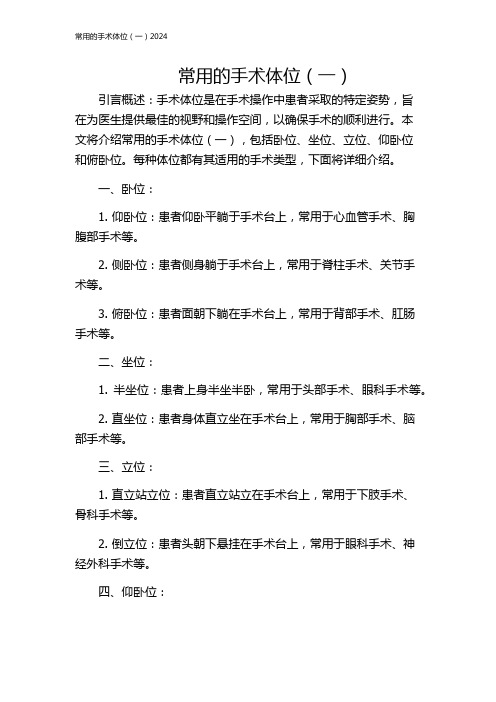
常用的手术体位(一)引言概述:手术体位是在手术操作中患者采取的特定姿势,旨在为医生提供最佳的视野和操作空间,以确保手术的顺利进行。
本文将介绍常用的手术体位(一),包括卧位、坐位、立位、仰卧位和俯卧位。
每种体位都有其适用的手术类型,下面将详细介绍。
一、卧位:1. 仰卧位:患者仰卧平躺于手术台上,常用于心血管手术、胸腹部手术等。
2. 侧卧位:患者侧身躺于手术台上,常用于脊柱手术、关节手术等。
3. 俯卧位:患者面朝下躺在手术台上,常用于背部手术、肛肠手术等。
二、坐位:1. 半坐位:患者上身半坐半卧,常用于头部手术、眼科手术等。
2. 直坐位:患者身体直立坐在手术台上,常用于胸部手术、脑部手术等。
三、立位:1. 直立站立位:患者直立站立在手术台上,常用于下肢手术、骨科手术等。
2. 倒立位:患者头朝下悬挂在手术台上,常用于眼科手术、神经外科手术等。
四、仰卧位:1. 头高仰卧位:患者仰卧,头部稍高抬,常用于颅内手术、颈部手术等。
2. 胸高仰卧位:患者仰卧,上半身高抬,常用于胸部手术、胃肠手术等。
五、俯卧位:1. 头低俯卧位:患者俯卧,头部低垂,常用于眼部手术、耳鼻喉科手术等。
2. 胸低俯卧位:患者俯卧,上半身低垂,常用于胸部手术、颈椎手术等。
总结:手术体位对手术操作至关重要,选择适当的体位有助于提供良好的视野和操作空间。
常用的手术体位包括卧位、坐位、立位、仰卧位和俯卧位。
每种体位都有其适用的手术类型,医生在选择体位时需根据手术部位和目的进行综合考虑。
正确的手术体位能够提高手术的成功率和患者的安全性。
颅脑手术入路选择的相关原则

颅脑手术入路选择的相关原则大脑是人体最重要也最复杂的器官之一,若大脑受损,会导致一系列严重后果,无论是脑卒中、颅脑外伤还是脑肿瘤、功能性疾病等,都需要通过颅脑手术进行治疗。
而保证手术能够顺利进行的要素众多,其中手术入路是保证体位正确安置的必要前提,手术入路的选择可以决定手术损伤、手术路径以及手术质量。
那么颅脑手术入路该如何选择呢?下面跟随小编一起来看看吧。
1常见手术入路1.1额部入路若颅脑手术部位主要在于额叶底部、额叶前部、鞍区、颅前窝底等部位,通常情况需协助患者保持平卧位,使用头架固定头颅后,选择双额发际内冠状切口,仅须切开病变侧单侧骨瓣。
在眼眶上中线附近钻孔时,应当避免在上矢状窦及额窦。
1.2翼点入路若颅脑手术部位主要在于鞍上、鞍旁、蝶骨嵴、海绵窦等处,患者需要保持仰卧位,将其头部进行对侧旋转、后伸,同时使用头架固定,选择翼点入路,采用额项部弧形切口,常适用于前循环动脉瘤、基底动脉尖动脉瘤手术。
1.3颞部入路若患者手术部位在额叶、海马、颅中窝底等处,可选择颞部入路,采取“马蹄形”切口,患者需取侧卧位,保证病侧向上。
1.4项枕部入路若患者手术部项叶、枕叶、大脑镰中后部等,可选择项枕部入路,多采用侧卧位,“马蹄形”或直线切口。
1.5经枕小脑入路经枕小脑入路适用于中脑及松果体区手术,患者需取侧卧位或俯卧位,在头皮做“马蹄形”切口。
1.6枕下后正中及旁正中入路枕下后正中入路多用于小脑蚓部、第四脑室、脑干背侧及枕下减压手术,患者需呈侧卧、俯卧位,并使用头架对头部进行固定,拔针颈部能够伸展,做直切口。
而枕下旁正中入路适用于脑桥小脑三角、脑干外侧及小脑外侧等部位的手术,患者可保持侧卧或仰卧位,头部需转向病变对侧,做与中线平行的直切口。
2手术入路选择原则首先,颅脑手术入路与普通外科手术入路具有相同的选择原则,即需要保证距离最近且手术视野暴露充分,需要特殊注意的一点为颅脑手术需避开患者脑功能区。
理想的手术入路,是能够在严格保护患者正常脑血管结构的同时,保证没有手术盲点,使病变能够经手术得到彻底的处理。
颅腔内肿瘤切除手术记录

颅腔内肿瘤切除手术记录患者信息:姓名:XXX性别:XXX年龄:XXX手术记录:手术日期:XXX手术医生:XXX一助:XXX二助:XXX术前准备:在手术前进行了全面的术前评估,包括患者的临床症状、体征、血液检查、影像学检查等,以确保手术的可行性和安全性。
术前给予患者充分的解释和告知,患者及家属理解并同意进行手术。
手术过程:1. 麻醉方式:采用全麻,由麻醉科医生负责,患者麻醉安全平稳。
2. 体位:将患者置于XXX侧卧位,头低足高。
3. 消毒:采用严格的无菌操作,对手术区域进行消毒。
4. 骨瓣切割:用XXX钻进行骨瓣切割,开颅XXXxcm,保护好脑组织。
5. 颅内探查:术者、一助援助下,逐层进行颅内探查,发现位于XXX位置的肿瘤,约XXX大小。
6. 肿瘤切除:细致切除肿瘤,注意不损伤周围重要结构,操作中有辅助器械协助。
7. 出血控制:肿瘤切除过程中,出血较多,采用电凝、生物胶、缝扎等方式进行出血控制。
8. 遗留腔内注射:术后在腔内注射XXX药物,以防止肿瘤复发。
9. 清理手术物:彻底清理手术区域,保持洁净。
10. 骨瓣复位:用XXX钢板复位固定。
11. 皮肤缝合:采用XXX方式进行皮肤缝合。
12. 愈合处理:手术完成后,对伤口进行敷料处理,加压包扎。
术后恢复:1. 术后转入重症监护室,进行密切观察,注意生命体征、神经功能变化等情况。
2. 术后监测:进行常规的血液检查、头颅CT/MRI等检查,以评估手术效果和术后情况。
3. 病情观察:观察患者的病情变化,及时处理并记录。
4. 饮食与活动:根据患者病情,逐步增加饮食和活动量。
5. 术后用药:根据需要,给予患者必要的止痛、抗感染、促进愈合等药物治疗。
6. 术后随访:安排术后随访计划,进行定期随访,观察手术效果与患者康复情况。
术后并发症:1. 术中未发生明显的并发症。
2. 术后X天,患者出现头痛、恶心、呕吐等症状,给予对症处理,症状缓解。
3. 术后X天,患者伤口愈合良好,未见感染迹象。
神经外科手术体位
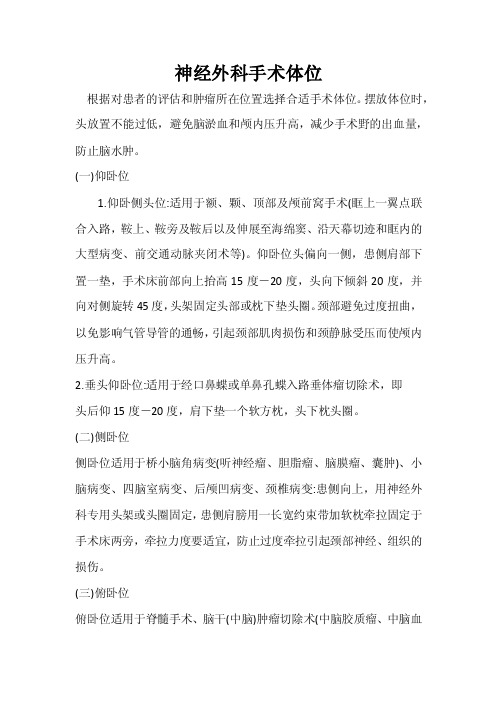
神经外科手术体位根据对患者的评估和肿瘤所在位置选择合适手术体位。
摆放体位时,头放置不能过低,避免脑淤血和颅内压升高,减少手术野的出血量,防止脑水肿。
(一)仰卧位1.仰卧侧头位:适用于额、颗、顶部及颅前窝手术(眶上一翼点联合入路,鞍上、鞍旁及鞍后以及伸展至海绵窦、沿天幕切迹和眶内的大型病变、前交通动脉夹闭术等)。
仰卧位头偏向一侧,患侧肩部下置一垫,手术床前部向上抬高15度-20度,头向下倾斜20度,并向对侧旋转45度,头架固定头部或枕下垫头圈。
颈部避免过度扭曲,以免影响气管导管的通畅,引起颈部肌肉损伤和颈静脉受压而使颅内压升高。
2.垂头仰卧位:适用于经口鼻蝶或单鼻孔蝶入路垂体瘤切除术,即头后仰15度-20度,肩下垫一个软方枕,头下枕头圈。
(二)侧卧位侧卧位适用于桥小脑角病变(听神经瘤、胆脂瘤、脑膜瘤、囊肿)、小脑病变、四脑室病变、后颅凹病变、颈椎病变:患侧向上,用神经外科专用头架或头圈固定,患侧肩膀用一长宽约束带加软枕牵拉固定于手术床两旁,牵拉力度要适宜,防止过度牵拉引起颈部神经、组织的损伤。
(三)俯卧位俯卧位适用于脊髓手术、脑干(中脑)肿瘤切除术(中脑胶质瘤、中脑血管网状细胞瘤、先天性肿瘤)。
使用神经外科专用头架固定。
1.俯卧位时注意勿使患者胸、腹部受压,以保持其呼吸通畅及下肢静脉回流正常。
男性患者尤应注意勿使生殖器受压。
2.保持深静脉穿刺管及导尿管通畅。
3.俯卧位时使用头架前,应注意涂抹红霉素眼药膏于结膜囊,并覆盖护肤帖膜,避免头架损伤眼睛。
因可能由于手术造成头部于头架位置偏区,术中定时观察患者头架压迫区域,并加以按摩。
(四)坐位坐位适用于幕下后颅窝开颅术I.为患者双下肢缠绷带时,要松紧适度,减少下肢血液淤积。
2.使用坐位架时,保持头、颈在同一轴线,头部以适宜方法固定于坐位椅的头架上。
患者胸前与坐位椅之间放一软方枕,背部加衬垫,并用约束带从患者背部将其固定于坐位椅上,双下肢置于长脚蹬上,保持功能位。
颅内肿瘤手术的麻醉
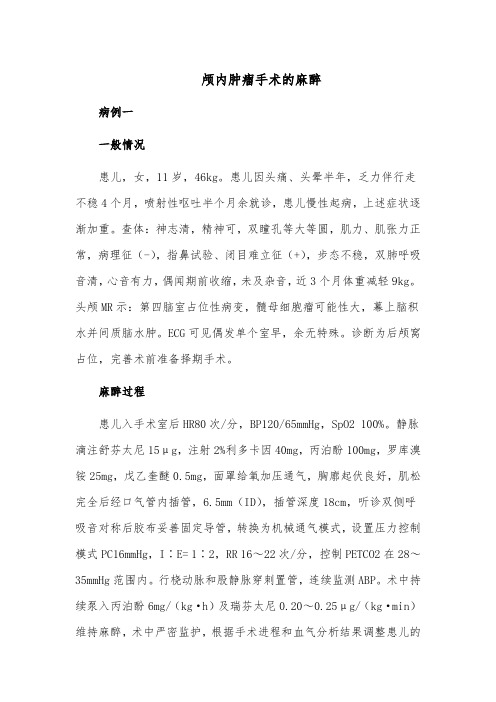
颅内肿瘤手术的麻醉病例一一般情况患儿,女,11岁,46kg。
患儿因头痛、头晕半年,乏力伴行走不稳4个月,喷射性呕吐半个月余就诊,患儿慢性起病,上述症状逐渐加重。
查体:神志清,精神可,双瞳孔等大等圆,肌力、肌张力正常,病理征(-),指鼻试验、闭目难立征(+),步态不稳,双肺呼吸音清,心音有力,偶闻期前收缩,未及杂音,近3个月体重减轻9kg。
头颅MR示:第四脑室占位性病变,髓母细胞瘤可能性大,幕上脑积水并间质脑水肿。
ECG可见偶发单个室早,余无特殊。
诊断为后颅窝占位,完善术前准备择期手术。
麻醉过程患儿入手术室后HR80次/分,BP120/65mmHg,SpO2 100%。
静脉滴注舒芬太尼15μg,注射2%利多卡因40mg,丙泊酚100mg,罗库溴铵25mg,戊乙奎醚0.5mg,面罩给氧加压通气,胸廓起伏良好,肌松完全后经口气管内插管,6.5mm(ID),插管深度18cm,听诊双侧呼吸音对称后胶布妥善固定导管,转换为机械通气模式,设置压力控制模式PC16mmHg,I∶E= 1∶2,RR 16~22次/分,控制PETCO2在28~35mmHg范围内。
行桡动脉和股静脉穿刺置管,连续监测ABP。
术中持续泵入丙泊酚6mg/(kg·h)及瑞芬太尼0.20~0.25μg/(kg·min)维持麻醉,术中严密监护,根据手术进程和血气分析结果调整患儿的电解质平衡和血液管理,体征大致平稳。
手术历时4.5小时,出血约400ml,术中补充晶体液1300ml,胶体液500ml,输入RBC 2U,FFP100ml。
术毕前查血气示:pH7.38;PCO236mmHg;21.0mmol/L;BE- 4mmol/L;HCT28%;电解质大致正常。
患儿体征大致平稳,手术医师考虑手术时间长、创伤大,患儿带管送至ICU继续观察治疗。
给予患儿术后镇痛,PCA配方:舒芬太尼90μg,生理盐水100ml,昂丹司琼8mg,泵速2ml/h。
颅内占位手术手术指引

颅内肿瘤切除术手术指引1.概念:(1)人脑由大脑、小脑、间脑和脑干等部分组成。
(2)每一侧半球包括:额叶、顶叶、颞叶及枕叶。
(3)大脑包括左右半球及中间的上、下蚓部,以上中下脚与脑干相连。
间脑位于大脑两半球之间,其外侧面与大脑两半球之内侧面相连,其间有深而窄的垂直正中裂隙,称为第三脑室。
(4)脑干是由中脑、桥脑、延髓组成,它们相互连接,背后连接小脑,头端连接间脑,尾端连接脑干与小脑之间有第四脑室。
颅内肿瘤是神经系统中常见的疾病之一,一般分为原发和继发两大类。
可发生于任何年龄,但多见于20~50岁的青壮年。
颅内肿瘤发生于大脑半球的机会最多,其后依次为蝶鞍区、小脑(包括小脑蚓部)、桥小脑角、脑室内、脑干。
其治疗方式仍以手术切除为主。
2.手术方式:颅内肿瘤切除术3.手术体位:(1)仰卧位:适用于额部、前颅底、颞部、鞍区、中颅窝、顶前部、纵裂等(2)俯卧位:适用于后颅窝或脊髓4.麻醉方式:全身麻醉5.仪器设备:脑外科动力系统,电刀,吸引器,显微镜,6.物品准备:(1)器械准备:辅料包、手术衣、治疗碗、新脑包、电钻包、脑外科四件套(2)一次性物品准备:1/4/7缝线、阑尾针、电刀、23#/11#刀片、双极电凝(长细型)、输液器、吸引器、头皮夹、骨蜡、医用薄膜、脑外科薄膜、明胶海绵、脑棉、冲洗球、显微镜套。
7.手术配合:洗手护士配合:(1)提前30min洗手上台,整理器械台,准备手术用物,与巡回护士共同清点棉片、缝针及其他敷料数目。
(2)手术野皮肤常规消毒、铺巾,贴神经外科专用贴膜。
用艾力斯分别固定好电刀、双极电凝、滴水管及吸引管。
(3)常规切开皮肤、皮下及帽状腱膜层,翻开皮瓣。
1)递手术刀切开皮肤及帽状腱膜层2)递头皮夹钳上头皮夹,头皮止血3)递双极电凝止血,递手术刀或脑膜剥离器,钝性或锐性分离,帽状腱膜下疏松组织层,向皮瓣基底部翻转4)用双极电凝于皮肤腱膜瓣内面止血5)用盐水纱布垫于基底部外面,递湿的盐水纱布覆盖于其内面,头皮勾牵引固定皮瓣(4)去骨瓣后,暴露硬膜,将硬脑膜悬吊于骨窗边缘。
显微镜下颅内肿瘤摘除手术的护理配合

体护理计划 , 特别是对视力 和听力有 障碍的病人更要体贴入微 ,
ta r na tmO u d r o n e ta t n 极 电凝 ; r c a iI u r n e g ig xr ci o 特殊敷料 : 如不同规格 的脑棉片 、 止血纱布 、 明胶 海绵 把
u d i r s op n erm o c e c
n u io— e r —ma— ombn d s b c ii la d ifaa y i hn p ra h n —c ie u ocpt n n tlb rn tie a po c a
ui rt al ha drJ .N hnd( ,9 6 1 7 :8 s ga a b edbi [ ] oS i n ot e e k 池 18 ,4( ) 8 7—
位, 以及头部皮肤准备情 况 ; 帮助视力和 听力有 障碍的病人稳妥 的躺 在手术 床上 , 注意保 暖 ; 建立 静脉通 路 , 别选择上肢 桡静 分 脉和右 _肢 的踝静 脉 , 连接 三通 固定好 , F 并 以保证 术中补液 、 输 血通 畅 ; ②合理摆 放体 位, 以病 人舒适 、 全 、 安 无损 伤为原则 _ , 3 J
r i [] S r e t ,9 8 27 2 8 e o J . ugN u l 8 , — 9 . gn o1 9 [ ] 符利 君, 5 吴怀 兰, 张南南 , . 等 显微神经外科手术 中特殊体位 的安置 及护理[ ]中华 护理杂志 , 0 ,0 6 :6 — 7 . J. 2 5 4 ( )4 9 4 0 0 作者简介 : 包纯纯(9 8 ) 女 , 1 7一 , 护师 , 大专, 工作单位 :2 0 0 温州医学 3 50 , 院附属第一医院 ; 茜 、 叶瑶 、 卫红工作单位 ;2 0 0 温州 医学 院附属 林 350 ,
脑瘤手术实施方案

脑瘤手术实施方案脑瘤是一种常见的神经外科疾病,对患者的生活质量和健康造成严重影响。
脑瘤手术是治疗脑瘤的重要手段之一,下面将介绍脑瘤手术的实施方案。
一、手术前准备1. 术前评估:对患者进行全面的身体检查和相关检查,包括头部CT、MRI等影像学检查,评估脑瘤的位置、大小和周围组织的情况。
2. 术前准备:患者需要进行术前准备,包括禁食禁水、清洁手术部位、心理护理等。
二、手术操作1. 麻醉:在手术前对患者进行全身麻醉,确保患者在手术过程中不会感到疼痛。
2. 头部定位:在确定手术部位后,对患者的头部进行固定定位,确保手术操作的准确性。
3. 切口:根据脑瘤的位置和大小确定切口位置,并进行皮肤消毒,切开头皮和颅骨。
4. 穿刺:在确定脑瘤位置后,进行脑实质穿刺,达到脑瘤的部位。
5. 切除:根据脑瘤的性质和位置,进行脑瘤的切除,尽量保护周围正常脑组织,避免损伤。
三、术后护理1. 监护:术后患者需要进行严密监护,包括生命体征监测、神经系统监测等。
2. 休息:术后患者需要充分休息,避免剧烈运动和过度劳累。
3. 恢复训练:术后患者需要进行康复训练,包括语言康复、运动康复等,帮助患者恢复功能。
四、术后随访1. 复查:术后患者需要进行定期复查,包括头部影像学检查、神经系统功能评估等。
2. 术后指导:对术后患者进行术后指导,包括饮食指导、生活方式指导等,帮助患者更好地康复。
脑瘤手术是一项复杂的手术,需要严密的术前评估、精准的手术操作和细致的术后护理。
只有全面的护理措施和科学的操作方法,才能确保手术的成功和患者的康复。
希望医护人员能够严格按照脑瘤手术实施方案进行操作,为患者提供更好的治疗效果。
各种手术体位的摆放及注意事项
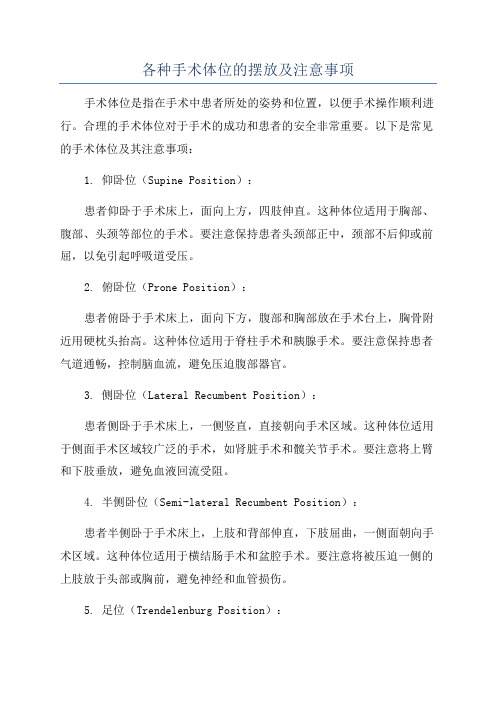
各种手术体位的摆放及注意事项手术体位是指在手术中患者所处的姿势和位置,以便手术操作顺利进行。
合理的手术体位对于手术的成功和患者的安全非常重要。
以下是常见的手术体位及其注意事项:1. 仰卧位(Supine Position):患者仰卧于手术床上,面向上方,四肢伸直。
这种体位适用于胸部、腹部、头颈等部位的手术。
要注意保持患者头颈部正中,颈部不后仰或前屈,以免引起呼吸道受压。
2. 俯卧位(Prone Position):患者俯卧于手术床上,面向下方,腹部和胸部放在手术台上,胸骨附近用硬枕头抬高。
这种体位适用于脊柱手术和胰腺手术。
要注意保持患者气道通畅,控制脑血流,避免压迫腹部器官。
3. 侧卧位(Lateral Recumbent Position):患者侧卧于手术床上,一侧竖直,直接朝向手术区域。
这种体位适用于侧面手术区域较广泛的手术,如肾脏手术和髋关节手术。
要注意将上臂和下肢垂放,避免血液回流受阻。
4. 半侧卧位(Semi-lateral Recumbent Position):患者半侧卧于手术床上,上肢和背部伸直,下肢屈曲,一侧面朝向手术区域。
这种体位适用于横结肠手术和盆腔手术。
要注意将被压迫一侧的上肢放于头部或胸前,避免神经和血管损伤。
5. 足位(Trendelenburg Position):患者仰卧于床上,头部低于脚部,腿部向上抬高。
这种体位适用于产科手术和腹腔手术。
要注意控制气道,防止四肢静脉回流受阻,避免腿部神经损伤。
在安排手术体位时-安全:手术体位必须保证患者的安全,避免压迫重要器官、血管和神经。
-通气和氧合:手术体位应保证患者的呼吸道通畅,避免呼吸困难和低氧。
-血液循环:手术体位影响血液回流和供血,要避免血流动力学的不稳定。
-保暖:手术体位改变患者体表面积的暴露,导致体温下降,应保证患者的体温稳定。
-安抚患者:手术体位改变患者的位置和姿势,患者可能感到不适,要及时安抚患者的情绪。
总之,手术体位的选择和正确摆放对于手术的顺利进行和患者的安全至关重要。
冠状切口双额开颅前颅窝底入路切除肿瘤
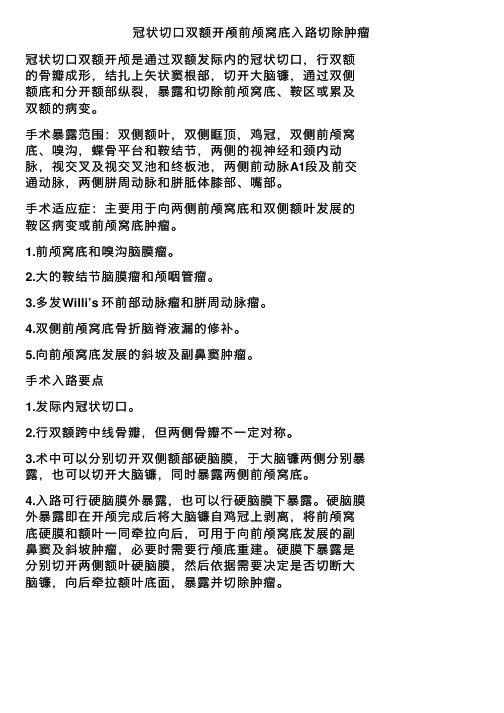
冠状切⼝双额开颅前颅窝底⼊路切除肿瘤冠状切⼝双额开颅是通过双额发际内的冠状切⼝,⾏双额的⾻瓣成形,结扎上⽮状窦根部,切开⼤脑镰,通过双侧额底和分开额部纵裂,暴露和切除前颅窝底、鞍区或累及双额的病变。
⼿术暴露范围:双侧额叶,双侧眶顶,鸡冠,双侧前颅窝底、嗅沟,蝶⾻平台和鞍结节,两侧的视神经和颈内动脉,视交叉及视交叉池和终板池,两侧前动脉A1段及前交通动脉,两侧胼周动脉和胼胝体膝部、嘴部。
⼿术适应症:主要⽤于向两侧前颅窝底和双侧额叶发展的鞍区病变或前颅窝底肿瘤。
1.前颅窝底和嗅沟脑膜瘤。
2.⼤的鞍结节脑膜瘤和颅咽管瘤。
3.多发Willi’s 环前部动脉瘤和胼周动脉瘤。
4.双侧前颅窝底⾻折脑脊液漏的修补。
5.向前颅窝底发展的斜坡及副⿐窦肿瘤。
⼿术⼊路要点1.发际内冠状切⼝。
2.⾏双额跨中线⾻瓣,但两侧⾻瓣不⼀定对称。
3.术中可以分别切开双侧额部硬脑膜,于⼤脑镰两侧分别暴露,也可以切开⼤脑镰,同时暴露两侧前颅窝底。
4.⼊路可⾏硬脑膜外暴露,也可以⾏硬脑膜下暴露。
硬脑膜外暴露即在开颅完成后将⼤脑镰⾃鸡冠上剥离,将前颅窝底硬膜和额叶⼀同牵拉向后,可⽤于向前颅窝底发展的副⿐窦及斜坡肿瘤,必要时需要⾏颅底重建。
硬膜下暴露是分别切开两侧额叶硬脑膜,然后依据需要决定是否切断⼤脑镰,向后牵拉额叶底⾯,暴露并切除肿瘤。
图1 双额发际内冠状切⼝,切⼝两端点连线满⾜两侧眉⼸暴露图2 沿帽状腱膜下层游离⽪瓣图3 颅⾻钻孔(必要时中线两侧钻孔)图4 双额⾻瓣成形,⾻蜡封闭额窦,硬膜悬吊图5 双额硬脑膜分别弧形切开图6 缝扎上⽮状窦图7 切断⽮状窦并切开⼤脑镰图8 结扎⽮状窦和切开⼤脑镰后,分别向前后牵拉图9 双额底暴露范围及周围解剖关系图10 双额底联合纵裂⼊路相关解剖额底联合纵裂暴露的范围⾮常⼴泛,从中线到两侧。
来⾃⿐腔顶部嗅粘膜的嗅丝于嗅沟内形成嗅球并附着于嗅沟内,嗅神经后部稍细,两侧呈⼋字分开,后端⽌于额叶底⾯的嗅三⾓。
各种手术体位的摆放及注意事项

各种手术体位的摆放及注意事项手术体位的摆放和注意事项是手术室中非常重要的一环,它直接关系到手术操作的顺利进行和患者的安全。
本文将对各种手术体位的摆放和注意事项进行详细介绍。
1.仰卧位仰卧位是最常见的手术体位之一,经常用于胸腹部手术。
在摆放患者时,应保证患者头部与锁骨平行,颈部稍微后仰,双手放在身体两侧。
在操作过程中,需要注意避免头部过度后仰,以免引起气道梗阻或头部静脉回流受阻。
2.俯卧位俯卧位适用于脊柱手术等需要手术部位朝下的手术。
患者应该躺在手术床上,头部侧着,以减轻面部压力。
在摆放过程中,要确保患者的颈部和躯干呈直线,双手自然下垂。
为避免脸部水分蒸发过快,需要使用保护措施,如涂擦保湿剂或贴上保湿膜。
3.半坐位半坐位适用于腰椎手术等需要手术部位呈半坐姿的手术。
在摆放患者时,患者的臀部应尽量靠近手术床边缘,背部直立,低肢自然垂下。
需要注意避免头部过度前屈或后仰,以免引起呼吸困难。
4.侧卧位侧卧位适用于髋关节手术等需要手术部位横置的手术。
在摆放患者时,患者应位于手术床中央,躯干和下肢均呈30°-45°的弯曲状态。
为保证患者的呼吸通畅,需要使用枕头支撑患者的上肢和颈部。
5.头低位头低位适用于颅脑手术等需要手术部位头部稍微低于胸部的手术。
在摆放患者时,患者的头部需要向下垂,以便减少脑组织充血。
需要注意避免导致颈部过度过伸或过屈,以免引起颈动脉供血不足。
在手术体位的摆放过程中,还需要注意以下几点:1.保证患者的舒适和安全。
手术前应向患者介绍手术的目的和过程,充分沟通并取得患者的同意。
在摆放患者时,要注意避免过度拉伸患者的肢体,以免引起肌肉拉伤或神经损伤。
2.定时翻身、松解肢体。
长时间保持一种体位对患者的身体和心理健康都会产生一定影响。
在手术过程中,要定时帮助患者翻身或松解肢体,以保证患者的血液循环和神经功能正常。
3.保持手术部位的清洁和暖和。
手术部位清洁是手术安全的基础,应在摆放患者时注意保持手术部位干燥和无菌。
颅内肿瘤的护理常规
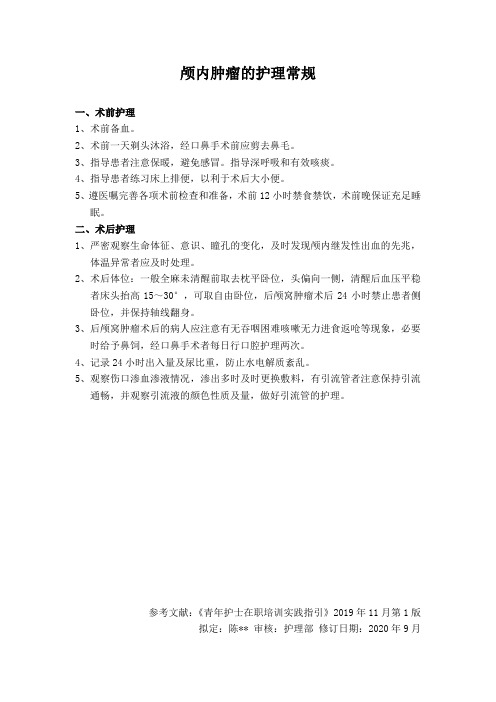
颅内肿瘤的护理常规
一、术前护理
1、术前备血。
2、术前一天剃头沐浴,经口鼻手术前应剪去鼻毛。
3、指导患者注意保暖,避免感冒。
指导深呼吸和有效咳痰。
4、指导患者练习床上排便,以利于术后大小便。
5、遵医嘱完善各项术前检查和准备,术前12小时禁食禁饮,术前晚保证充足睡
眠。
二、术后护理
1、严密观察生命体征、意识、瞳孔的变化,及时发现颅内继发性出血的先兆,
体温异常者应及时处理。
2、术后体位:一般全麻未清醒前取去枕平卧位,头偏向一侧,清醒后血压平稳
者床头抬高15~30°,可取自由卧位,后颅窝肿瘤术后24小时禁止患者侧卧位,并保持轴线翻身。
3、后颅窝肿瘤术后的病人应注意有无吞咽困难咳嗽无力进食返呛等现象,必要
时给予鼻饲,经口鼻手术者每日行口腔护理两次。
4、记录24小时出入量及尿比重,防止水电解质紊乱。
5、观察伤口渗血渗液情况,渗出多时及时更换敷料,有引流管者注意保持引流
通畅,并观察引流液的颜色性质及量,做好引流管的护理。
参考文献:《青年护士在职培训实践指引》2019年11月第1版
拟定:陈** 审核:护理部修订日期:2020年9月。
常用的手术体位及适应证(一)

常用的手术体位及适应证(一)引言概述:手术体位是指手术过程中患者的身体姿势,它对手术操作的顺利进行和患者的安全起着重要的作用。
本文将介绍常用的手术体位及其适应证,以便医务人员在手术前正确选择和使用合适的体位,提供安全、高效的手术服务。
正文:一、仰卧位(平卧位)1. 背部手术:背部手术如脊柱手术、胸腹部手术需要患者处于仰卧位,方便手术区域暴露。
2. 心脏手术:心脏手术如冠状动脉搭桥术、心脏瓣膜置换术通常要求患者保持平卧位,有利于手术器械操作。
3. 颅脑手术:颅脑手术如颅脑肿瘤切除术、颅脑血管修复术需要患者仰卧位,便于神经导航及病灶清除。
4. 整形手术:整形手术如面部整形手术、乳房整形手术通常要求患者保持仰卧位。
二、俯卧位1. 胃肠道手术:胃肠道手术如胃肠切除术、结肠癌切除术需要患者处于俯卧位,方便手术区域的暴露和操作。
2. 腹腔手术:腹腔手术如腹腔镜手术、腹腔切除术常要求患者保持俯卧位,有利于手术探查和器械操作。
3. 前列腺手术:前列腺手术如前列腺切除术需要患者处于俯卧位,方便手术操作和止血。
4. 脊柱手术:脊柱手术如脊柱融合术、植骨融合术通常要求患者保持俯卧位,有利于手术器械的定位和安置。
三、侧卧位1. 膀胱手术:膀胱手术如膀胱肿瘤切除术、膀胱造口术需要患者处于侧卧位,便于手术区域的操作和探查。
2. 肾脏手术:肾脏手术如肾切除术、肾移植术常要求患者保持侧卧位,方便手术暴露和器械的操作。
3. 颈部手术:颈部手术如颈淋巴结切除术、甲状腺手术通常要求患者处于侧卧位,有利于手术操作的视野和暴露。
4. 婴儿手术:婴儿手术如婴儿胸部手术、腹部手术常要求患者保持侧卧位,方便手术操作和监测。
四、坐卧位1. 腹腔手术:腹腔手术如腹腔镜手术、腹腔造瘘术需要患者处于坐卧位,方便手术操作和内脏的暴露。
2. 膀胱手术:膀胱手术如膀胱置换术常要求患者保持坐卧位,有利于手术暴露和操作。
3. 头颅手术:头颅手术如颅内导管置入术、颅内出血引流术通常要求患者处于坐卧位,利于手术操作和引流。
常见颅脑疾病术后的护理

形成脑脊液漏。
(3)脓腔引流
引流瓶(袋)应至少低于脓腔30厘 米,病人应取利于引流的体位。为避免 颅内感染扩散,应待术后24小时,创口 周围初步形成粘连后方可进行囊内冲洗, 冲洗后注入抗生素,然后夹闭引流管2至 4小时,引流管的位置应保留在脓腔的中 心,待脓腔闭合时拔管。
(4)硬脑膜下引流
术后病人取平卧位或头低脚高患侧
➢ (3)中枢性高热 ➢ (7)癫痫发作
➢ (4)尿崩症
(1)出血
颅内出血是脑手术后最危险的并
发症,多发生在术后24至48小时内。
病人往往有意识改变,表现为意识清
醒后又逐渐嗜睡、反应迟钝甚至昏迷。
术后出血的主要原因是术中止血不彻
底或电凝止血痂脱落,
其它如病人呼吸道不畅、二氧化碳 蓄积、躁动不安、用力挣扎等引起颅内 压骤然增高,也可造成再次出血。故术 后应严密观察,避免增高颅内压的因素, 一旦发现病人有颅内出血征象,应及时 报告医师,并做好再次手术止血的准备。
卧位,注意体位引流。引流瓶(袋)应
低于创腔30厘米。术后不使用强力脱水
剂,亦不严格限制水分摄入,以免颅压
过低影响脑膨出。通常于术第三日拔
除引流管。
谢谢
4、止痛及镇静
切口疼痛多发生于手术后24小时内, 给予一般止痛剂可奏效。颅内压增高引 起的头痛,多发生在术后2至4日脑水肿 高峰期,常为搏动性头痛,严重时伴有 呕吐,需依赖脱水、激素治疗降低颅内 压,头痛始能缓解。
若系术后血性脑脊液刺激脑膜引起的 头痛,需手术后早期行腰椎穿刺引流血 性脑脊液,至脑脊液逐渐转清,头痛自 然消失。应注意脑手术后不论何种原因 引起的头痛均不可轻易使用吗啡和哌替 啶,因此类药物有抑制呼吸的作用,不 仅影响气体交换,还有使瞳孔缩小的副 作用,影响临床观察。
术中体位的摆放与注意事项

术中体位的摆放与注意事项术中体位与注意事项在手术过程中,选择合适的术中体位对保障病人术后康复至关重要,同时术中体位的使用还与手术的成功、术后并发症的发生率以及病人的安全直接相关。
因此,在进行手术安排和实施手术操作前,需要仔细考虑术中体位的摆放和注意事项,以确保手术操作的成功性和病人的安全性。
一、术中体位的选择根据手术部位、手术性质以及手术方法的不同,术中体位也不尽相同。
以下为常见手术部位术中体位的摆放:1、头部手术:头低脚高位、头高脚低位或仰卧位。
2、颈部手术:仰卧位,或头低脚高位。
3、胸部手术:侧卧位、俯卧位或半坐位。
4、腹部手术:仰卧位、头低脚高位或侧卧位。
5、骨盆手术和下肢手术:仰卧位、头低脚高位或侧卧位。
6、脑部手术:仰卧位或头低脚高位。
二、术中体位的注意事项在术中体位的摆放过程中,为确保病人的安全和手术的成功,需要注意以下问题:1、病人的头部、颈部和脊椎的保护头部、颈部和脊椎是人体的重要组成部分,需要得到充分的保护。
在选择术中体位的时候,需要遵循医学准则摆放,避免在摆放时对头、颈、脊椎等部位施加过大的压力。
如果术中需要头高脚低位,则需要注意病人头部高度和保持气道的通畅,同时还需要防止过度的伸展颈部引起颈部神经根受损。
2、病人的肢体的保护手术摆放之后,病人的肢体也需要得到保护。
在术前,需要检查病人肢体上的压力点,避免长时间压迫导致肢体生化障碍等情况。
同时,需要注意肢体的角度、支撑点等问题,以便操作顺利。
3、术中安全在手术过程中,需要保持现场整洁,避免污染和感染。
同时,手术室内也需要保持恒温、湿度适宜。
在手术过程中,需要保持病人气道畅通、血流畅通,防止感染、失血、窒息等意外。
4、手术团队的配合手术团队的配合也是手术成功的重要因素之一。
在进行术中摆放的过程中,需要保持术中团队之间的沟通紧密,做好术中的协同工作,确保手术的顺利进行。
五、结语术中体位对手术的成功和病人的安全至关重要。
在术前摆放术中体位时,需要考虑手术部位、手术性质和手术方法,遵循医学准则选择合适的体位。
颅脑手术常用手术体位

手术体位
总要求: 一、患者舒适安全、无并发症; 二、充分暴露术野、便于医生操作; 三、固定安全牢靠、不易移动; 四、神经血管不受压、不影响呼吸循环。
颅脑手术常用手术体位
平卧位
侧卧位
额叶、 颞叶、部分顶叶肿瘤 垂体瘤开颅手术 颅咽管手术 部分侧脑室肿瘤 大脑中动脉 后交通动脉 前交通动脉瘤的夹闭术 大部分的急诊脑出血(幕上脑出 血)。
1、平卧位
床单位准备:
头部:铺防水单 身部:铺布中单 要求:平整无皱褶
1、平卧位
方法与步骤:护理皮肤
视病人皮肤及手术 时间长短情况,对 病人受压处皮肤进 行必要防护。 保护眼角膜及耳朵。
1、平卧位
方法与步骤:护理皮肤 上头架
准备好头架连接杆、 头钉 配合医生上好头架。
1、平卧位
方法与步骤:护理皮肤 上头架
颅脑手术常用手术Biblioteka 位*** 麻醉科层级学习目标 N0-N1
N2以上
掌握:颅脑体位摆放的要点 熟悉:体位摆放的总要求 了解:手术体位的概念 能力目标:在老师指导下完成颅脑 体位的摆放。
1
掌握:颅脑手术体位的摆放 熟悉:体位摆放的总要求 了解:手术体位的概念 能力目标:能指导N0-N1完成颅 脑体位的摆放。
3、俯卧位
俯卧位摆放的方法与步骤: 护理皮肤 整理管道
整理好管道和连接线, 为翻身搬抬病人做好准 备
3、俯卧位
俯卧位摆放的方法与步骤: 护理皮肤 整理管道 搬抬病人
医生听统一口令翻转, 抬起病人的同时我们放 好胸垫,垫单拉平整, 注意呼吸循环不受压。
3、俯卧位
俯卧位摆放的方法与步骤: 护理皮肤 整理管道 搬抬病人 关注受压 固定肢体
关注受压处有无杂物压 身下。肢体功能位并且 不影响医生站位。
- 1、下载文档前请自行甄别文档内容的完整性,平台不提供额外的编辑、内容补充、找答案等附加服务。
- 2、"仅部分预览"的文档,不可在线预览部分如存在完整性等问题,可反馈申请退款(可完整预览的文档不适用该条件!)。
- 3、如文档侵犯您的权益,请联系客服反馈,我们会尽快为您处理(人工客服工作时间:9:00-18:30)。
Intrinsic Cerebral Tumor Operative Approach and Patient PositionsThe surgical approach and patient positioning varies depending on the location of the intrinsic cerebral tumor and will be described separately.Frontal Lobe TumorsFrontal lobe tumors can essentially be divided into two different locations, depending on the proximity of the lesion to the midline. For those lesions that are found within 4 cm of the midline, the head of the patient can essentially be positioned straight up or turned slightly to the contralateral side after fixation with the three-point Mayfield head holder device. This also applies to tumors that are situated deeply within the anterior portion of the cingulated gyrus in front of the rolandic cortex. The incision extends from above the zygomatic arch to the anterior hairline and may be extended down onto the forehead slightly if the tumor is situated very far anteriorly. Should that be necessary, this incision is closed with subcuticular sutures and Steri-Strips (3M, St. Paul, MN) in that portion that involves the forehead (Fig. 1). For tumors situated more than 4 cm from the midline, positioning is facilitated by turning the head nearly 60 degrees toward the contralateral side, with a roll placed under the ipsilateral shoulder (Fig.2). The incision is essentially the same and, when this is done on the dominant hemisphere side, the scalp is infiltrated around the incision extending from the zygomatic arch above the ear and forward along the forehead in a circumferential pattern. When the tumor is within 1 to 2 cm of the rolandic cortex, it will be necessary to either expose the motor tract to facilitate stimulation-induced mapping or to stimulate the motor cortex with a subdural strip electrode should this area not be exposed because of an anteriorly placed craniotomy.额叶肿瘤额叶肿瘤依据病变距中线的距离基本上可分为2个不同的位置。
对于距中线4cm 内的病变,患者的头位可在Mayfield头架固定后垂直或向对侧轻度偏斜摆放。
这个头位同样可应用于rolandic皮层(即中央区)前的扣带回前部的深处肿瘤。
手术切口自颧弓至前发际,如果肿瘤非常靠前,则切口可向前额轻度延长。
如果必要的话,切口术后采用皮内缝合或创可贴(3M, St. Paul, MN)粘合,包括前额部(图1)。
对于距中线4cm之外的肿瘤,患者头部向对侧旋转约60°,同侧肩下垫圆枕(图2)。
当这是在优势半球端操作时,切口基本上是相同的,头皮切口周围浸润是从颧弓到耳朵上方再到前额部的圆周形式。
对于在rolandic皮层1-2cm内的肿瘤,有必要暴露运动束以诱导刺激定位,如果因为先前开颅而未能得到充分暴露,可以用硬膜下电极片刺激运动皮层而获得暴露。
FIGURE 1. Illustration showing the surgical position and scalp incision for frontal tumors within 4 cm of the midline.FIGURE 2. Illustration showing the surgical position and scalp incison for frontal tumors lateral to 4 cm of the midline.Temporal TumorsFor tumors involving the anterior half of the temporal lobe, the head is turned nearly 90 degrees contralateral to the lesion, with the head remaining parallel to the floor. When the lesion extends very far mesially near the cerebral peduncle and above the uncus, the head should be flexed toward the floor by 10 degrees. The incision extends from the zygomatic arch just above the pinna of the ear, and then superiorly toward the anterior hairline (Fig. 3, A and B). Should the tumor be located on the dominant hemisphere, the anesthetic scalp block again parallels the incision in a circumferential fashion (Fig. 4, A–C).。
When the tumor involves the posterior half of the temporal lobe, the head positioning remains the same but the incision extends from the zygomatic arch superiorly and thenposteriorly to end well behind the pinna of the ear in a horseshoe-type fashion. Again, should the exposure be on the dominant hemisphere side, the area of the incision is circumferentially infiltrated with local anesthetic.颞叶肿瘤对于前半颞叶内的肿瘤,病变侧头需向病变对侧旋转近90度,整个头部保持与地面平行。
当病变延伸很远,邻近中线附近的大脑脚及钩回之上,此时头部应向地板弯曲10度。
切口从颧弓延伸,沿耳廓上方,超越前发际线(图3,A和B)。
如果肿瘤位于优势半球,先行头皮阻滞麻醉,再以圆周形式平行延伸切口。
当肿瘤位于颞叶的后半部,头部定位仍然同前,但切口从颧弓上方开始,向后延伸,以马蹄形形式结束于耳廓后方。
同时,如果肿瘤位于优势半球侧,切口范围需用药物行局部浸润麻醉。
(图4,A-C)FIGURE 3. Illustrations showing the surgical position and scalp incision for anterior (A) and posterior (B) temporal lobe tumors.FIGURE 4. Illustrations showing the scalp incision and local anesthetic infusion for parietal tumor resection (A), frontotemporoinsular tumors (B), and anterior temporal tumors (C) under awake mapping conditions.Insular TumorInsular-based tumors provide a special challenge to the surgeon; thus, positioning must be adequate to achieve the desired goals of the surgical exposure and resection, depending on the location of the lesion above or below the sylvian fissure. For insular tumors in which the majority of the lesion is above the sylvian fissure, the patient’s head is turned a minimum of 60 degrees contralateral to the tumor, with the head extended nearly 15 degrees superiorly in relation to the floor. This allows for the resection to parallel the insular vessels, which are slanted toward the temporal lobe (Fig. 5A). When the majority of the insular tumor is located inferior to the sylvian fissure, the head should be turned nearly 90 degrees contralaterally and flexed inferiorly toward the floor nearly 15 degrees (Fig. 5B). This allows for direct visualization into the inferior aspect of the insula once the superior middle temporal gyrus is resected or retracted. This also provides access to the inferior portion of the uncinate fasciculus, which is facilitated by thehead-down position. If the lesion extends very far posteriorly, at least to the end of the posterior limb of the internal capsule, the head should not be turned 90 degrees but should remain 60 degrees from the straight up position to facilitate access to the posterior portion of the lesion. Should the insula be approached in the dominant hemisphere, the anesthetic block will again encompass in a circumferential fashion the incision, which typically extends from the zygomatic arch above the pinna of the ear and forward to the anterior hairline.岛叶肿瘤岛叶肿瘤对于外科医生来说是一个特殊的挑战,正因如此,体位的摆放必须适于获得理想的视野暴露和手术切除,取决于病变在外侧裂上还是外侧裂下。
